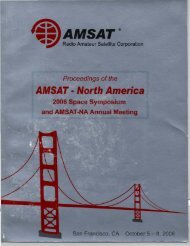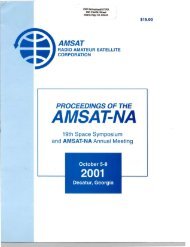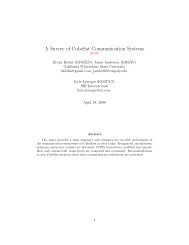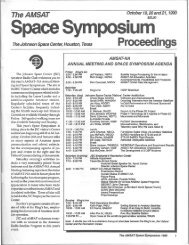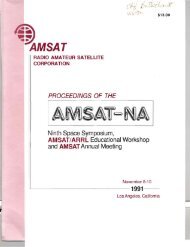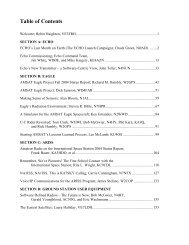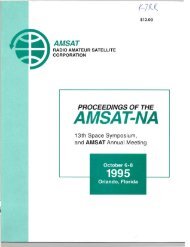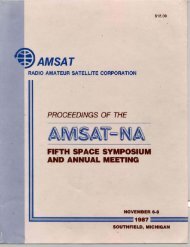October 27-29, 2000 - Klofas.com
October 27-29, 2000 - Klofas.com
October 27-29, 2000 - Klofas.com
You also want an ePaper? Increase the reach of your titles
YUMPU automatically turns print PDFs into web optimized ePapers that Google loves.
3.6V Li-Ion battery packs are used to provide redundancy and buffer the power generated by the external GaAs<br />
photovoltaic panels.<br />
Satellite <strong>com</strong>munications is ac<strong>com</strong>plished through FM Amateur Radio Frequencies. Use of two frequencies, the 144<br />
MHz band for transmitting and 440 MHz band for receiving, maintains flexibility, decreases transceiver <strong>com</strong>plexity,<br />
and allows the satellite to be used as a HAM radio repeater. Deployable dipole antennas, one for each band, provide<br />
fairly efficient transmission strength and the passive pointing provided by the earth's magnetic field insures good<br />
ground reception as the satellite passes over North America.<br />
3.2.4 Conclusion<br />
The DARTSat team has focused its efforts on the development of the satellite service bus. Payloads for DARTSat<br />
are under development here at Dartmouth and at other institutions. These include plasma and auroral mapping<br />
experiments and unique GPS applications. Because the extremely modular nature of DARTS at allows for payloads<br />
to be conceived and produced independently from the satellite services, a wide variety of payloads from a large<br />
number ofsources are possible.<br />
3.3 University of Tokyo<br />
3.3.1 Introduction<br />
Intelligent Space Systems Laboratory (ISSL), a laboratory directed by Prof. Nakasuka in the Department of<br />
Aeronautics and Astronautics, University of Tokyo, has been studying a large membrane space structure for several<br />
years with an intention to apply it to huge solar cells, <strong>com</strong>munication antenna, debris catcher or other missions 7 • 9 •<br />
One way to deploy such large membrane in space is to use centrifugal force. The mission of ISSt's CUBESAT is to<br />
experiment the deployment of large thin film solar cells using centrifugal force generated by spinning the satellite<br />
main body. Figure 3.3.1 shows the image of the satellite with its membrane deployed. The results of the<br />
experiments will be useful for studying the way of deploying a huge membrane as well as finding out a simple way<br />
to provide large power to small satellites without much <strong>com</strong>plicated systems.<br />
Arrangement of Solar Cells<br />
Figure.3.3.1 Image ofUniv. of Tokyo CUBESAT<br />
on orbit with Membrane Deployed<br />
Figure 3.3.2 Configuration of Membrane (after deployment)<br />
In the CUBESAT mission, we specified the following four success levels, which also show the mission scenario.<br />
Level 1) Educational objectives to experience satellite design, fabrication, testing, launch, operation and analysis of<br />
results.<br />
31



